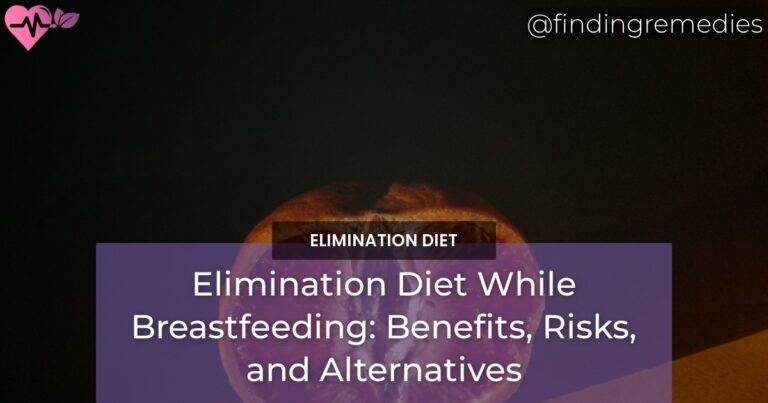If you’re a breastfeeding mother, you may have heard of an elimination diet before. This type of diet involves removing certain food groups or specific foods from your diet in order to identify and eliminate potential allergens that may be affecting your baby’s health.
In this article, we will explore the benefits, risks, and alternatives to an elimination diet while breastfeeding, as well as provide tips to ensure adequate nutrient intake and avoid common mistakes.
Table of Contents
Benefits of Elimination Diet While Breastfeeding
An elimination diet while breastfeeding can provide numerous benefits for both you and your baby. By identifying and eliminating potential allergens from your diet, you may be able to:
- Reduce the risk of allergic reactions in your baby
- Improve infant health and behavior
- Reduce colic and other digestive issues in your baby
- Improve maternal health and well-being
Common allergens that may be removed from the diet include:
- Dairy
- Eggs
- Soy
- Wheat
- Tree nuts
- Shellfish
ALSO READ
Risks of Elimination Diet While Breastfeeding
While an elimination diet while breastfeeding can provide numerous benefits, there are potential risks and side effects to consider as well. Some of these include:
- Nutrient deficiencies due to a lack of variety in the diet
- Inadequate protein intake
- Increased stress and anxiety related to following a restricted diet
- Reduced milk supply due to a lack of calorie intake
- Increased risk of disordered eating patterns
It is important to discuss any changes to your diet with a healthcare professional to ensure that you are meeting your nutrient needs and avoiding potential risks.
How Long to Follow an Elimination Diet While Breastfeeding
The ideal duration of following an elimination diet while breastfeeding can vary depending on the individual and the specific allergens being eliminated. In general, it is recommended to follow the diet for a minimum of 2-4 weeks in order to allow sufficient time for potential allergens to be eliminated from the body. However, some individuals may need to follow the diet for longer periods of time if symptoms persist.
Factors that can affect the length of the elimination diet include the severity and frequency of symptoms, the number of potential allergens being eliminated, and individual variations in nutrient needs.
Alternatives to an Elimination Diet While Breastfeeding
For some breastfeeding mothers, following an elimination diet may not be practical or desirable. Alternative options for identifying and addressing food sensitivities or allergies in your baby include:
- Hypoallergenic formulas
- Eliminating one food at a time and monitoring symptoms
- Consulting with a healthcare professional for additional testing or guidance
What to Do if Accidentally Consuming a Food to Be Eliminated
Inevitably, there may be times when you accidentally consume a food that should be eliminated from your diet. In this case, it is important to monitor your baby for any potential symptoms or reactions, which may include:
- Hives
- Rashes
- Diarrhea
- Colic
- Difficulty breathing
If your baby does experience any symptoms or reactions, it is important to seek medical attention as soon as possible.
Reintroducing Foods After Elimination Diet While Breastfeeding
After following an elimination diet while breastfeeding, it is important to gradually reintroduce eliminated foods back into your diet in order to avoid adverse reactions. Some steps to take when reintroducing foods include:
- Introduce one food at a time
- Eat small amounts of the food initially
- Monitor your baby for any potential symptoms or reactions
If your baby does experience any symptoms or reactions, it may be necessary to eliminate the food from your diet again and consult with a healthcare professional for additional guidance.
Common Mistakes to Avoid When Following an Elimination Diet
When following an elimination diet while breastfeeding, there are common mistakes that may be made. These include:
- Eliminating too many foods at once, leading to nutrient deficiencies
- Assuming that a lack of symptoms means that a particular food is safe to consume
- Not seeking guidance from a healthcare professional when necessary
It is important to approach an elimination diet with caution and to seek guidance from a healthcare professional to ensure that you are meeting your nutrient needs and avoiding potential risks.
Ensuring Adequate Protein Intake While Following an Elimination Diet
One potential risk of following an elimination diet while breastfeeding is inadequate protein intake. However, there are many protein-rich foods that can be incorporated into the diet, including:
- Lean meats
- Poultry
- Fish
- Beans and legumes
- Nuts and seeds
- Dairy alternatives such as soy milk or almond milk
It is important to include a variety of protein-rich foods in your diet in order to meet your nutrient needs and support both your health and your baby’s health.
Conclusion
An elimination diet while breastfeeding can be a useful tool for identifying and addressing potential food sensitivities or allergies in your baby. However, it is important to approach this type of diet with caution and to seek guidance from a healthcare professional to ensure that you are meeting your nutrient needs and avoiding potential risks. Alternative options for identifying and addressing food sensitivities or allergies may be necessary for some breastfeeding mothers. By taking the appropriate steps to ensure adequate nutrient intake and avoid common mistakes, you can support both your health and your baby’s health while following an elimination diet.
RELATED ARTICLES:

